In the rapidly evolving software development landscape, Artificial Intelligence (AI) has emerged as a transformative force, redefining traditional methodologies, and significantly enhancing productivity. From automating tasks to optimizing complex processes, AI technologies are revolutionizing the way software is conceptualized, developed, and deployed. This article delves into some ways with examples in which AI is empowering software developers and catalyzing innovation to drive productivity in the digital era.
AI Models for Productivity
Artificial Intelligence (AI) models represent the forefront of technological innovation, leveraging advanced machine learning algorithms to solve complex problems and empower developers. Developed through a combination of research, data analysis, and iterative refinement.
The development of AI models begins with identifying a pressing challenge or a specific domain where AI-powered solutions can make a meaningful difference. Researchers start a process of data collection, curation, and preprocessing, amassing large datasets that serve as the foundation for training robust machine learning models. These datasets often encompass diverse sources of information, ranging from structured data in databases to unstructured text, images, and multimedia content from the web.
With the datasets, researchers employ a variety of machine learning techniques, including supervised learning, unsupervised learning, and reinforcement learning, to train AI models capable of understanding patterns, making predictions, and generating insights relevant to the target problem. The training process involves iteratively adjusting model parameters and architectures, and leveraging feedback mechanisms to enhance performance and generalization capabilities.
In the case of Codellama, a specialized AI model designed to assist developers in writing efficient and error-free code, the development process entails training deep learning models on vast repositories of code snippets, programming languages, and software development best practices. By analyzing patterns in code structures, identifying common programming errors, and recommending optimal solutions, Codellama aims to streamline the software development process, improve code quality, and enhance developer productivity.
Llama2, Algorithms
CodeLlama is based on Llama 2 (Llama 2 is a family of pre-trained and tuned large language models (LLMs) released by Meta AI in 2023. It is licensed for commercial use and open source) and is available in three models: CodeLlama, CodeLlama Python and CodeLlama Instruct.
Each model was released in three sizes with 7B, 13B, and 34B. (At the end of January 2024, the 70B version was released).

Code Llama specialization pipeline (Code Llama: Open Foundation Models for Code)
Automated Code Generation
One of the most prominent applications of AI in software development is automated code generation. AI-powered tools, such as code generators and auto-completion plugins, leverage machine learning algorithms to analyze existing codebases, understand coding patterns, and generate snippets or even entire modules of code. This not only accelerates development cycles but also minimizes human errors, thereby enhancing code quality and reliability.
How to Install Ollama and Codellama
Before we dive into the installation process, let’s take a moment to understand Ollama. Ollama is an AI-powered tool that allows you to run large language models (LLM) locally, right on your own computer. There is no need to worry about connectivity or privacy concerns.
- To install Ollama on your PC, you must first download the installer from the official Ollama website (https://ollama.com/download). Navigate to the download section and locate the version of Ollama compatible with your operating system. Once you find the appropriate installer, click the download button to initiate the download process.

- The installation wizard will guide you through installing Ollama on your PC. Follow the on-screen instructions, read, and accept the license agreement, and choose the destination folder where you want Ollama to be installed. You can also select any additional options or settings according to your preferences.
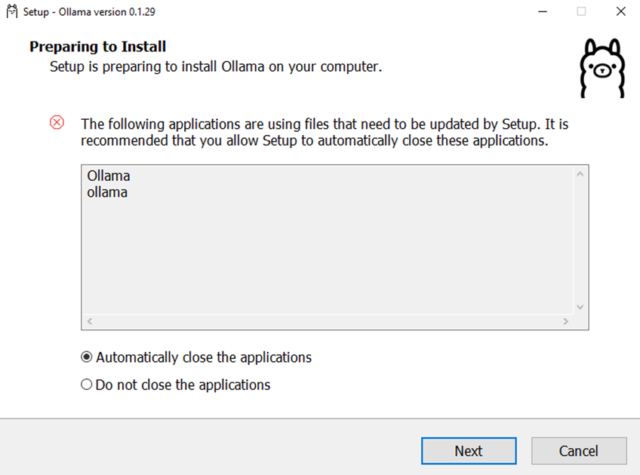
- If your operating system is Windows, you must add Ollama to the system variables.
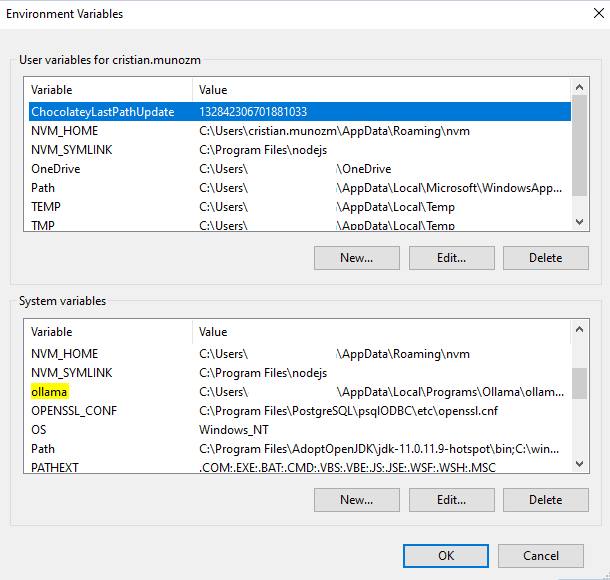
- Once the installation is complete, you will see a confirmation message indicating that Ollama has been successfully installed on your PC. You can now launch Ollama by double-clicking on its desktop shortcut or by searching for it in the Start menu, you can run the “ollama” command to verify that the installation was successful.
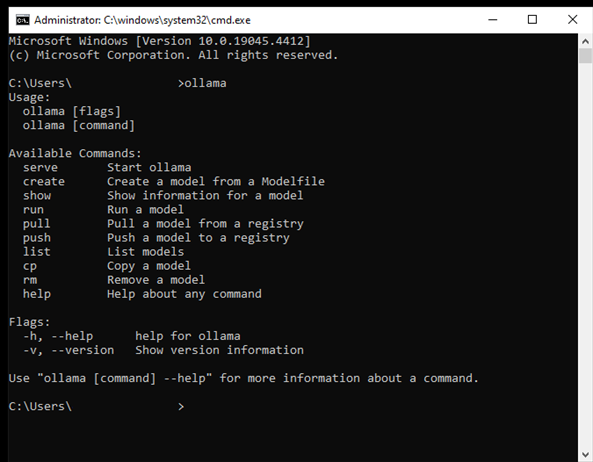
- To use a model, for example, Llama 2, you must type the command “ollama run llama2: 7b”. When a model is not installed on your computer, the tool will first perform the download and then you can interact with it.
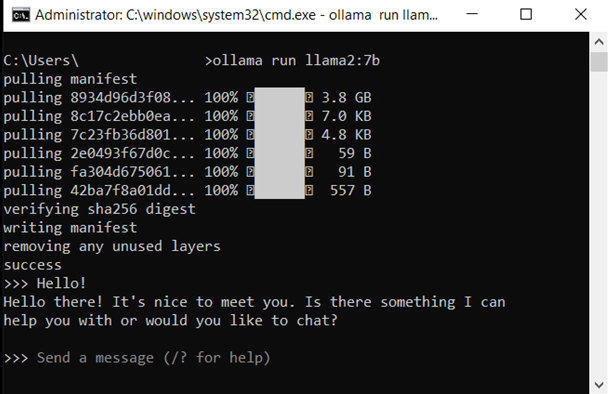
Install Continue
Integrating Ollama with your code editor can enhance your coding experience by providing AI assistance directly in your workspace. The Continue extension, available in Visual Studio Code, can achieve this.
- Click Install on the Continue extension in the Visual Studio Marketplace
- This will open the Continue extension page in VS Code, where you must click Install again.
- Once you do this, the Continue logo will appear on the left sidebar. If you click it, the Continue extension will open, and in the lower left part, we can select the model we want to use.
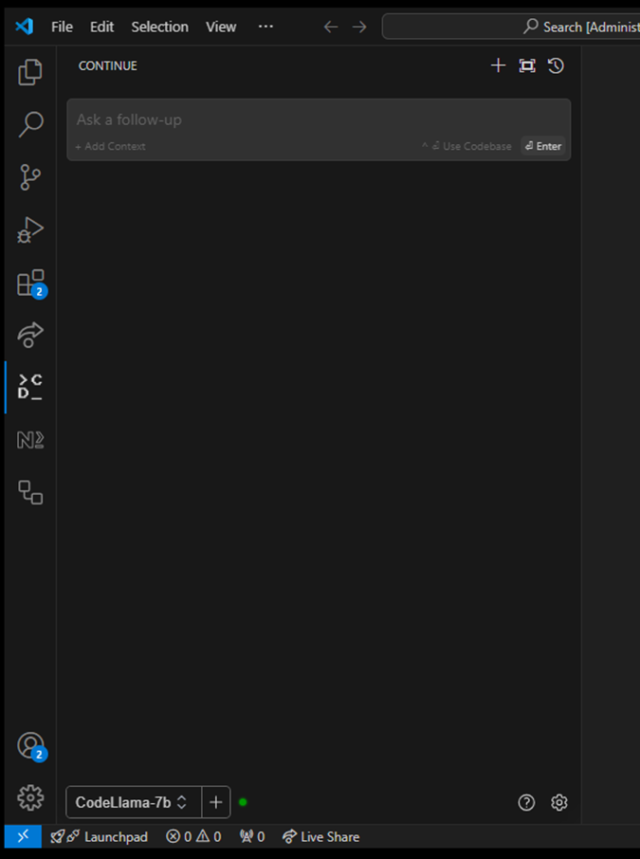
How to Understand the Current Code Base
In addition to generating code from scratch, CodeLlama allows us to analyze the code and explain its functionality. This capability speeds up the development process and improves the understanding of existing code, allowing developers to identify areas for improvement, fix bugs, and optimize performance.
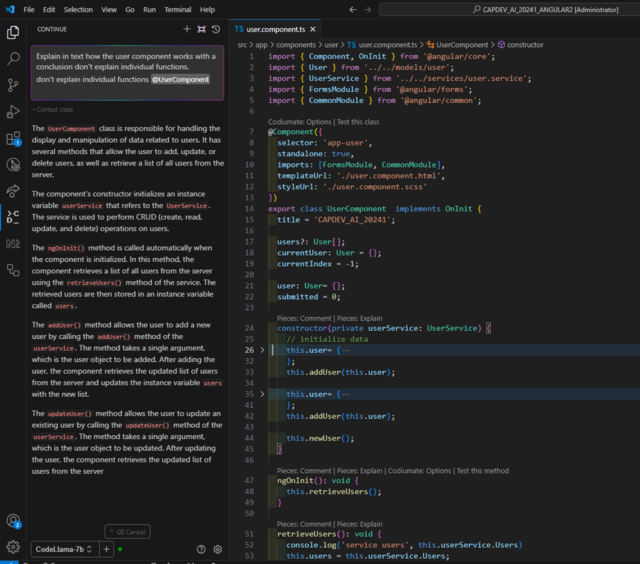
How to Run the Model – Provide Contexts
Codellama creates new implementations based on the context provided. This model uses natural language processing to analyze existing code files and produce new code that conforms to the conventions and structures of the previous project.
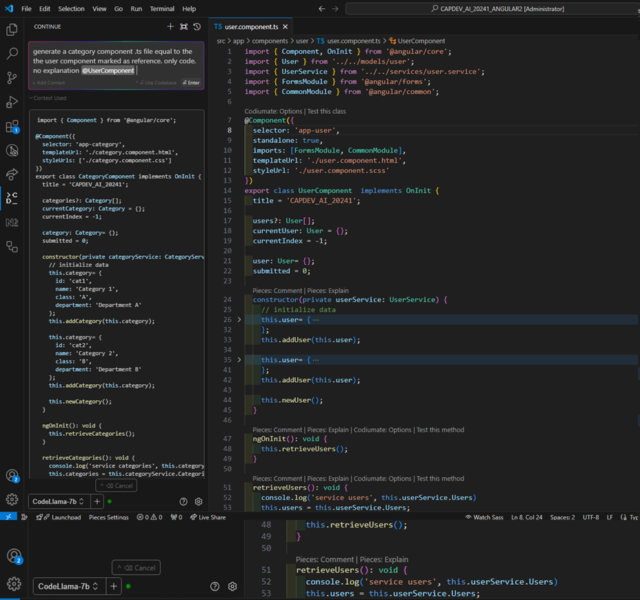
Intelligent Bug Detection and Resolution
Identifying and resolving bugs is an inherent part of the software development lifecycle. AI algorithms, particularly those based on machine learning, excel in analyzing vast datasets to detect anomalies and patterns indicative of potential bugs. Through techniques like anomaly detection and predictive analytics, AI can proactively identify areas of code prone to errors, enabling developers to preemptively address issues before they escalate. Furthermore, AI-powered debugging tools can suggest fixes or automatically generate patches that the developer must validate, accelerating the resolution process and minimizing downtime.
How to Detect Errors
CodeLlama not only generates new code based on context but also identifies and corrects errors in existing code files.
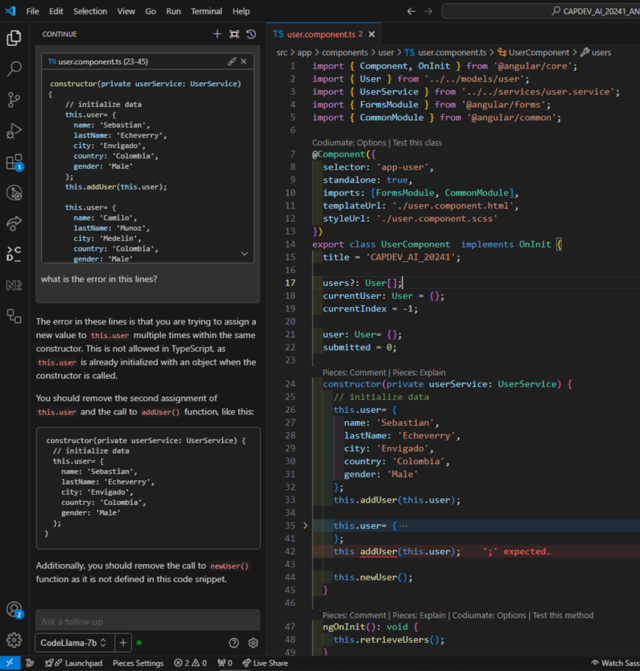
Enhanced Testing and Quality Assurance
Testing is essential for ensuring the functionality, performance, and security of software applications. AI-driven testing leverages techniques such as automated test case generation, intelligent test prioritization, and autonomous test execution to optimize testing processes. By simulating real-world scenarios and generating comprehensive test coverage, AI enables developers to generate better code coverage earlier in the development lifecycle, thereby reducing the time and effort spent on debugging and rework. Moreover, AI-powered test automation significantly accelerates regression testing and facilitates continuous integration and delivery (CI/CD), enabling faster release cycles without compromising quality.
Writing unit tests could not be easier. All you must do is provide the component as context and the correct prompt. The AI will be able to generate a unit test version according to your component, given that the unit test framework is trained within the model. An example prompt is the following:
“Please generate the unit tests for user.component @user.component.ts @user.component.html”
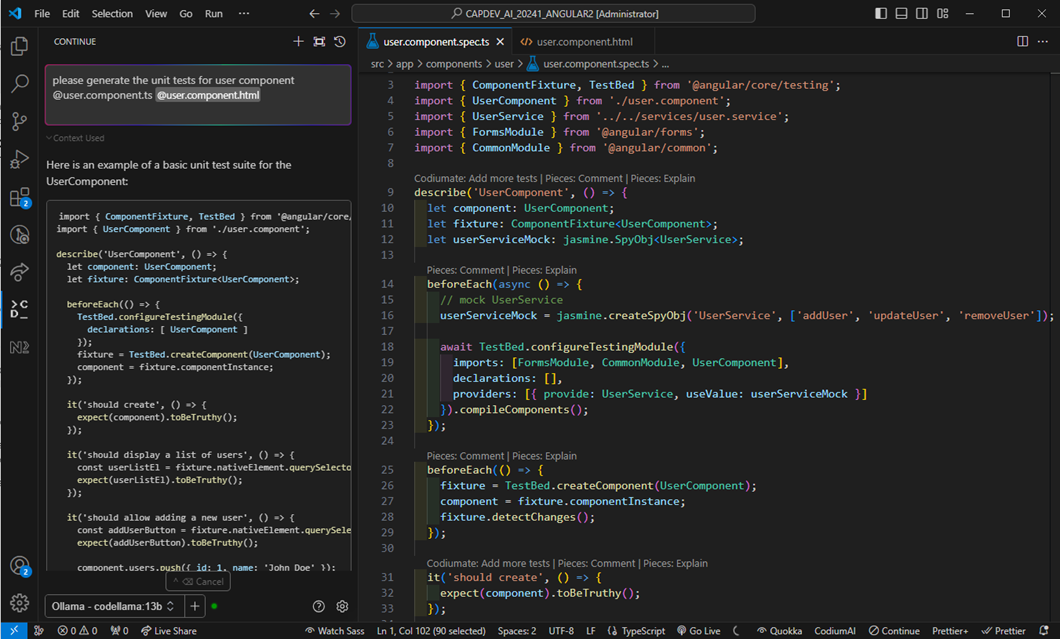
Important Takeaways
As artificial intelligence has many benefits, it also has important risks that must be addressed. It is important to understand that artificial intelligence is a tool that allows the developer to deliver faster software functionality, but that is not going to replace him/her. In this regard is the developer the person who defines the architecture and code style approach when leveraging these technologies, and not using the technology to drive a software development process.
Having the right knowledge when developing software is key now more than ever. For this, the developer has to have deep knowledge about the programming language, tools, and frameworks that he is using to structure a software application without affecting the final users because of a lack of quality in the final functionality because of a misuse of artificial intelligence, thus affecting software development companies’ reputation.
Developers should understand AI concepts, including machine learning, natural language processing (NLP), deep learning, and neural networks. This knowledge helps developers grasp how AI algorithms work and how they can be applied to enhance prompts and automate tasks in software development.
In conclusion, Artificial Intelligence is revolutionizing software development by augmenting developer capabilities, automating tedious tasks, and enabling data-driven decision-making. From automated code generation to intelligent bug detection, AI technologies are reshaping every facet of the software development lifecycle, enhancing productivity, accelerating time-to-market, and fostering innovation. As organizations embrace AI-driven development practices, they start to gain a competitive edge in the dynamic and highly competitive digital landscape.
Written in collaboration with Cristian Camilo Muñoz Martínez.


Fantastic insights on the integration of AI in software development! Codellama’s ability to streamline coding and improve quality is impressive. Consider exploring further advancements in AI-driven testing for even greater efficiency.